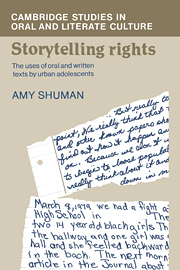Book contents
- Frontmatter
- Contents
- Acknowledgments
- Introduction
- 1 Fight stories: what counts is the recounting
- 2 Storyability and tellability
- 3 Collaborative uses of literacy in the adolescent community
- 4 Retellings
- 5 Varieties of contextuality
- 6 Familiarity and distance: toward a theory of oral and written personal narration
- Notes
- Bibliography
- Index
6 - Familiarity and distance: toward a theory of oral and written personal narration
Published online by Cambridge University Press: 05 November 2011
- Frontmatter
- Contents
- Acknowledgments
- Introduction
- 1 Fight stories: what counts is the recounting
- 2 Storyability and tellability
- 3 Collaborative uses of literacy in the adolescent community
- 4 Retellings
- 5 Varieties of contextuality
- 6 Familiarity and distance: toward a theory of oral and written personal narration
- Notes
- Bibliography
- Index
Summary
Literacy as a category
Speaking and writing have been contrasted as the epitome of the nature-culture dichotomy. Walter Ong states:
Speech wells up out of the unconscious, supported by unconsciously organized grammatical structures that even the most ardent structural and transformational grammarians now admit can never all be surfaced entirely into consciousness. Speech is structured through the entire fabric of the human person. Writing depends on consciously contrived rules.
(1979:3)This polarization of conscious and unconscious, contrivance and deep structure, and (stated later in the same essay) history and memory, abstract and concrete, leaves a great deal unexplained. The ability to speak is not the same as the ability to tell stories or to interpret the meaning behind someone's words. Although written standardized texts can often be distinguished from oral nonstandard ones, this distinction is complicated by such phenomena as texts that were written to be read aloud and by the use of ordinary language in literature.
Recent studies of literacy have eroded the absolute differences between writing and speaking. At the same time, in literacy studies, these categories are becoming polarized metaphors for social change, cultural differences, and the impact of technology on communication. Increasingly, literacy studies have provided evidence of a shift in our understanding of the categories of writing and speaking.
- Type
- Chapter
- Information
- Storytelling RightsThe Uses of Oral and Written Texts by Urban Adolescents, pp. 183 - 200Publisher: Cambridge University PressPrint publication year: 1986



